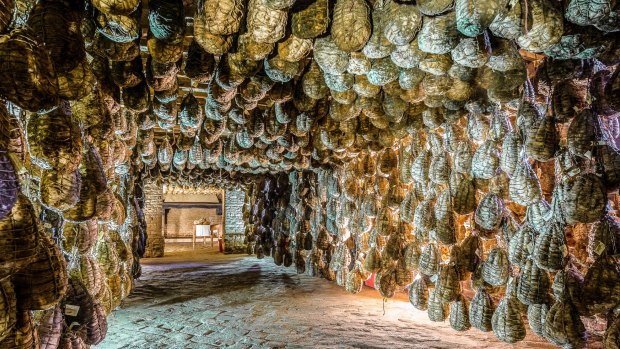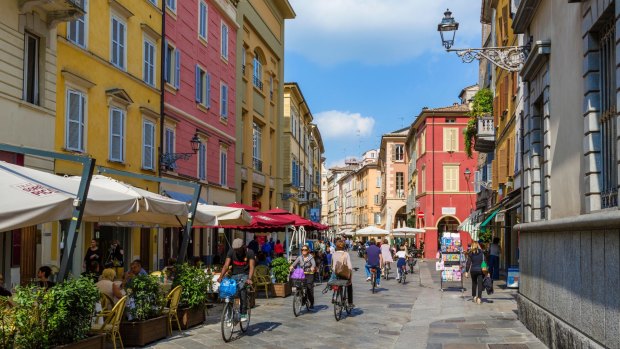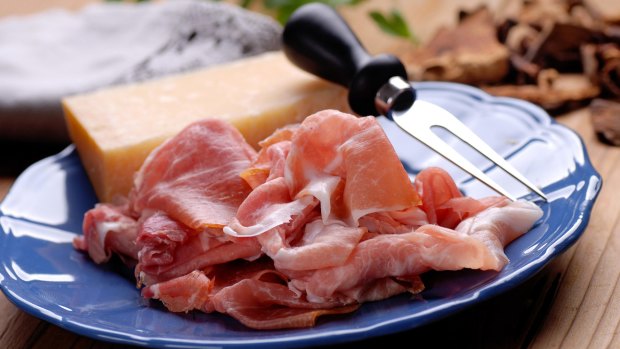This was published 5 years ago
Emilia-Romagna, Italy: One of the world's best food destinations

Polesine Parmense, the cellars for the ageing of salted pork in the Antica Corte Pallavicina Relais.Credit: Realy Easy Star/Giuseppe Masci / Alamy Stock Photo
All you see is a few farm buildings, a coughing tractor, maybe some rough-shaven men pruning vines. If you were just dawdling along this country road – though why would you, the landscape is flat and dull as pizza bianca – you'd never stop at Acetaia Leonardi.
Big mistake, because you'd never meet Ciara, she'd never show you around, and you wouldn't find yourself in an attic among cobwebby barrels that smell of caramel and comfort. You'd miss your chance to taste 20-year-old balsamic vinegar aged in cherry wood, sweet and sharp as love. Or balsamic vinegar from a rare juniper barrel, dark and syrupy with a hit of spice, like Claudia Cardinale in a 1960s movie.
And where else – where else on this whole planet Earth – would you see a barrel so ancient that bacteria have crystalised on the outside like lumpen limestone? The 150-year-old vinegar inside has a layered depth of flavour like old wine, but is thick and honeyed as a glaze. Drizzle it on strawberries, let it have its wicked way with your tastebuds, and you'll be its slave for life.

Strada Farini in the historic city centre, Parma, Emilia-Romagna.Credit: Alamy
Drive past Acetaia Leonardi, in short, and you'll miss one of the world's oldest producers of aged balsamic vinegar of Modena, one of the "Protected Designation of Origin" (DOP) products for which Emilia-Romagna is famous. Yet despite its famous foods, this northern region south of Venice and north of Tuscany is curiously overlooked by visitors to Italy. Its small cities – formerly powerful independent duchies such as Modena, Parma and Ferrara – pack a cultural punch. Of Italian cities not yet overwhelmed by tourists, Bologna is the most seductive for its pink palazzi, deli-dense streets and convivial university population.
Emilia-Romagna preserves a local vibe, a slower pace, an old-fashioned Italy of lazy wine-sipping at corner cafes and schoolkids kicking footballs in Renaissance piazzas. Long history, rich soils and a wealthy population bequeath it a fabulous food scene. It has more than 40 DOP foods and a cuisine that sits on the divide between Mediterranean and dairy-focused northern European cuisines. Dozens of museums and farm doors are devoted to its produce.
At Acetaia Leonardi, four generations of Leonardis have grown Trebbiano and Lambrusco grapes, then slow-simmered their juices and captured the concentrate in barrels made of oak, acacia or hawthorn. Every year one tenth of each barrel's vinegar is moved to the next barrel. The result, as Ciara explains, is that you finish with different flavours depending not on grape season, like wine, but in which wooden barrels the vinegar has been stored.

Parma ham and Parmesan cheese.Credit: ALFREDO COSENTINO / Alamy Stock Photo
As a tasting shows, young balsamic has all the cocky shallowness of teenagers. It gets up your nostrils and makes you wince. Medium-aged balsamic has a more harmonious balance of sweetness, sourness and acidity, and is mature enough to perk up meats and risotto. When stored for more than 10 years, the vinegar is balanced, toned down, agreeable. You can have it like a condiment with cheese or ice-cream, says Ciara or, if it's really aged, sip it like a digestif. Casanova considered it an aphrodisiac.
For the best cheese to match with the best balsamic, you don't have far to go. Travel west towards Parma and drive down another unprepossessing road towards a hangar of breezeblocks and corrugated iron, emblazoned with an unhelpful sign that says CPL Parma. Outside, workers dressed in white protection suits as if investigating an alien landing, smoke cigarettes. Inside, another great Italian product is conjured up: parmesan. Not, of course, the ersatz, pre-grated Australian supermarket variety but the real DOP deal, Parmigiano Reggiano, created no more than 25 kilometres from the Friesian cows that supply the milk.
A tour takes you among giant copper cauldrons like big, upside-down bells, where the milk is warmed, rennet and whey added, and enzymes set about their curdling. The curd sinks, and is then hauled out in cheesecloths. It tastes bland and spongy, and has to be moulded, floated in brine for 20 days, stacked on wooden shelves and aged for at least 12 months. The best food isn't hurried in this part of Italy. Each week the 40-kilo wheels are flipped over, brushed and tapped for air pockets. If any are found, the parmesan is downgraded and used for cooking, never as a table cheese.
Hit the shop afterwards and demand a tasting plate; the bargain price of one of the world's best cheeses will be a shock. Twelve-month parmesan, creamy and somewhat bland, is used by Italians for grating over pasta. In 24 months, the cheese develops crystalline granules and is stronger and crumbly. By the time it has aged 36 months, the cheese – now suited to the table rather than to cooking – is dark and dry, with a potent saltiness perfectly matched to a drizzle of sweet, aged balsamic. The sweet-salty fad of contemporary international cuisine is an established tradition in Emilia-Romagna.
While the curds are transformed into Parmigiano Reggiano, the remaining whey is used for ricotta, or is sent to farmers to feed their pigs. The pigs grow fat and sweet and provide another DOP delight, the regional prosciutto or Parma ham. If you've travelled across the world you'll want to taste the best, and that's culatello rump ham from black pigs. The haunches are massaged with garlic and red wine, covered in salt and pepper, sewn airtight into a pig's bladder and hung in cellars in the damp, mould-inducing Po Valley for up to 35 months. The pork leaches moisture and acquires concentrated sweetness before being unbound, soaked in white wine and eventually sold.
Try culatello (and scrumptious parmesan dumplings) at Antica Corte Pallavicina, which for once actually looks the part of a rustic, traditional food producer. The medieval, fortified farmhouse is surrounded by popular trees and stands of oak under which black pigs root for acorns. Some 5000 hams, whose mould stings your sinuses with ammonia, hang in a cellar with north-facing windows to let in winter's Po Valley cold fog. The finished product, sliced see-through thin and served in a sunny courtyard, dissolves on your tongue with nutty sweetness, velvet-soft and creamy.
Don't worry about your arteries clogging up in Emilia-Romagna. Locals claim all that fat is counteracted by the region's violet-coloured, sparkling Lambrusco, a simple, summery wine on its own, yet married with perfection to cold cuts. Just let the cork pop along with your tastebuds, and rejoice.
FIVE MORE REASONS TO VISIT EMILIA-ROMAGNA
MOTOR CARS
Ducati, Ferrari, Maserati and Lamborghini all hail from this rich industrial region (motorvalley.com). You can visit numerous motoring factories, racetracks and museums. The best is Museo Ferrari (musei.ferrari.com), which takes you through Ferrari history and has a Formula One simulator.
OPERA
Giuseppe Verdi was born in Busseto, where you can visit his home, a Verdi museum (museogiuseppeverdi.it) and the Verdi Theatre (turismo.comune.parma.it). Toscanini hailed from Parma, home to his birthplace museum and spectacular Regio Theatre (teatroregioparma.org), which hosts his operas.
MOSAICS
Coastal Ravenna (turismo.ra.it) was the former capital of the Western Roman Empire and is packed with 5th- and 6th-century churches covered in dazzling green, blue and gold Byzantine-style mosaics. The most fabulous are in the octagonal Basilica of St Vitale (ravennamosaici.it).
HISTORICAL ROUTES
Via dei Romei led pilgrims and crusaders between Venice and Rome. Via Francigena (viadifrancesco.it) remains a popular pilgrim route, part of the original Canterbury-to-Rome trail. In Modena region, you can trace three medieval trade routes on foot or by bicycle.
POTTERY
Emilia-Romagna town Faenza gave us the word ''faience''. You can buy the tin-glazed pottery throughout the region, often decorated with Renaissance motifs inspired by paintings and illuminated manuscripts. Imola (visitareimola.it) is known for hand-painted majolica in blue and white.
Brian Johnston travelled as a guest of the Italian State Tourist Board and Emilia-Romagna Tourism.
TRIP NOTES
MORE
FLY
Emirates flies from Sydney and Melbourne to Dubai (14.5 hours) with connections to Bologna (6.5 hours). See emirates.com/au
STAY
Tabiano Castello near Parma makes a great countryside base of exploration. Guestrooms and self-catering villas spread throughout a medieval village beneath a whopping castle with commanding views of the Po Valley. See tabianocastello.com
TASTE
Acetaia Leonardi has various farmhouse tours and balsamic-vinegar tastings. See acetaialeonardi.it
Antica Corte Pallavicina offers tours of its ham cellars and has a restaurant offering tasting plates. See anticacortepallavicinarelais.com
CPL Parma's factory tours highlight the parmesan-making process. See cplparma.it
Sign up for the Traveller Deals newsletter
Get exclusive travel deals delivered straight to your inbox. Sign up now.